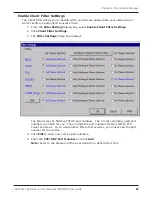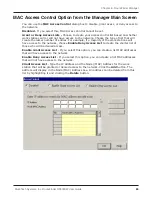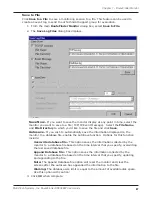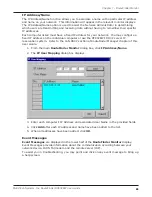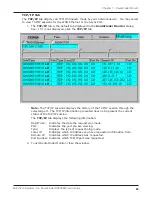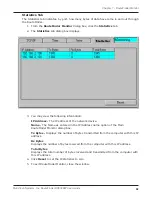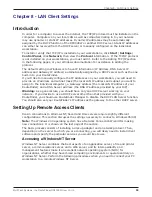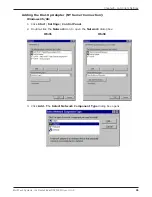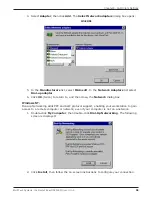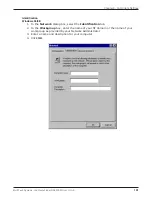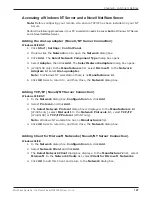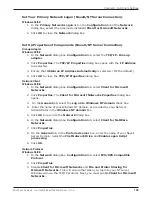
94
Chapter 8 - LAN Client Settings
Multi-Tech Systems, Inc. RouteFinder RF802EW User G
uide
Chapter 8 - LAN Client Settings
Introduction
In order for a computer to access the Internet, the TCP/IP protocol must be installed on the
computer. Computers on your local LAN as well as computers dialing in to your network
may use dynamic or static IP addresses. Dynamic IP addresses may be automatically
assigned by the DHCP function of the RF802EW or another DHCP server. Static IP addresses
can either be reserved from the DHCP server or manually configured on the individual
workstation.
To install or verify that TCP/IP is installed on your workstations, click
Start
|
Settings
|
Control Panel
, click
Network
, then view the
Protocol
information. If the TCP/IP protocol
is not installed on your workstations, you must add it. Refer to the Adding TCP/IP section
in the following pages, or your Windows documentation for assistance in adding the
protocol.
The default setting in Windows is to have IP information (IP Address, DNS Server IP
address and Gateway IP address) automatically assigned by a DHCP server such as the one
built-in to your RouteFinder.
If youd like to manually configure the IP addresses on your workstation, you will need to
provide an IP address and subnet mask (the local LAN IP address and subnet you want to
assign to the individual computer), a Gateway address (the local LAN IP address of your
RouteFinder) and a DNS Server address (the DNS IP address provided by your ISP).
Warning:
As a general rule, you should have only one DHCP server working on your
network. If you decide to use a DHCP server other than that provided with your
RouteFinder, you should use RouteFinder Manager to disable the DHCP LAN Server function.
You should also set your RouteFinders IP address as the gateway to the other DHCP server.
Setting Up Remote Access Clients
Dial-in connections to Windows NT, Novell and Unix servers require slightly different
configurations. This section discusses the settings necessary to connect a Windows 95/98/
Note:
The Windows 200 operating system has a Network Connection Wizard for making
new connections. It is shown on the last page of the section.
The basic process consists of installing a dial-up adapter and a network protocol. Then,
depending on the server to which you are connecting, you will likely need to install client
software and specify the particular services you would like to use.
Accessing a Windows NT Server
Windows NT Server combines the best aspects of an application server, a file and printer
server, a communications server, and a Web server, and its interoperability and
management features make it an excellent network operating system (NOS) for
organizations, whether they have mixed computing environments or operate entirely on
Windows NT Server. Perform the following procedures when you need to connect your PC
workstation to a remote Windows NT Server.
Summary of Contents for RouteFinder RF802EW
Page 1: ...Model RF802EW Wireless Router Access Point User Guide ...
Page 5: ...Chapter 1 Introduction ...
Page 10: ...Chapter 2 Hardware Installation ...
Page 13: ...Chapter 3 Software Installation and Configuration ...
Page 24: ...Chapter 4 Web Browser Configuration and Management ...
Page 47: ...Chapter 5 Telnet ...
Page 54: ...Chapter 6 RouteFinder Manager ...
Page 84: ...Chapter 7 RouteFinder Monitor ...
Page 93: ...Chapter 8 LAN Client Settings ...
Page 116: ...Chapter 9 LAN to LAN Settings ...
Page 119: ...Chapter 10 Troubleshooting ...
Page 123: ...Chapter 11 Service Warranty and Technical Support ...
Page 130: ...Appendixes Appendix A Appendix B Appendix C ...
Page 135: ...Glossary ...

